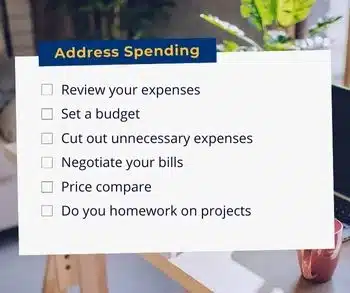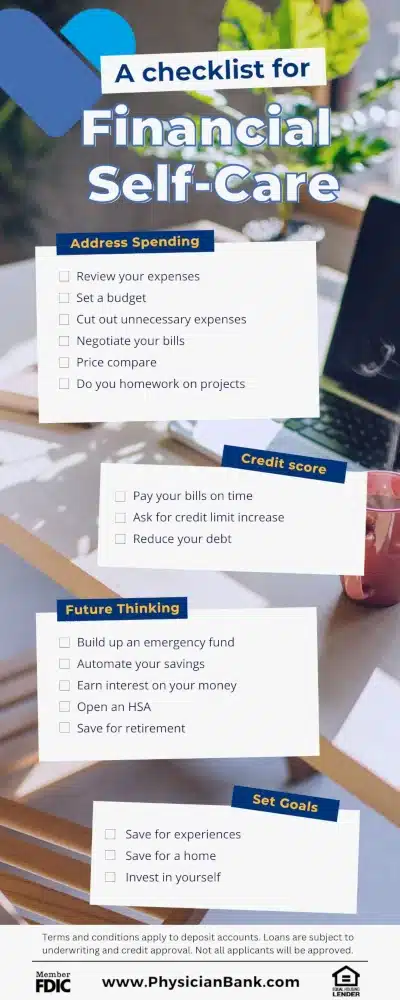Think self-care is just candles and bubble baths? With financial concerns being one of the most common causes of stress, don’t forget to make time for financial self care. It may seem like a trend, but it can make a big difference in your overall health and happiness. Let’s breakdown some ways to get your finances back on track with a financial self-care checklist.
Address Your Spending Habits

- Review your expenses: Knowing where your money goes is the first step in taking control of your finances. Take advantage of digital banking services, like Physician Bank offers, that feature spending reports by category. Be sure to consider expenses from checking accounts, credit cards, loans, and other sources.
- Review your expenses: Knowing where your money goes is the first step in taking control of your finances. Take advantage of digital banking services, like Physician Bank offers, that feature spending reports by category. Be sure to consider expenses from checking accounts, credit cards, loans, and other sources.
- Cut out unnecessary expenses: Subscriptions are easy to sign up for and even easier to forget about. Use your spending report to determine what you no longer use or need.
- Negotiate your bills: Feel like you’re paying too much for your monthly bills (think: cable, internet, insurance)? Call the company to negotiate a lower rate. It’s often easier than you think – and it can save you a lot of money in the long run.
- Price compare: Before making any major purchases, take the time to shop around and compare prices. You may be surprised at how much you can save by doing this. Keep in mind that major retailers known for discounts don’t always offer the lowest price.
- Do your homework on projects: DIY (do it yourself) projects may seem more affordable than hiring a contractor or service, but this isn’t always the case. With rising costs of materials, contractors can often get a better discount than you can. This savings could offset the cost of labor. Also consider what it would cost for a professional to fix your handiwork, should something go wrong.
Show Your Credit Score Some Love

- Pay bills on time: One factor in your credit score is whether you are able and willing to pay your debts. The easiest way to prove this is by paying on time.
- Ask for increases on your credit limits: Another factor in your credit score is your debt-to-credit ratio. This is the amount of credit you’re using compared with the amount of credit available to you. By asking for an increase on your credit limit, you can drastically improve this ratio. Make sure that your spending level doesn’t also increase.
- Reduce your debt: When budgeting, try to include more than the minimum payments for your loans and other debt. Can’t afford higher payments? Look for ways to consolidate your debts into a personal loan with a lower interest rate. Adjustable-rate loans can be a good option for paying down debt. These loans typically have lower introductory rates (sometimes even 0%). Make sure that your budget allows for you to pay off the loan before the introductory rate ends.
Financial Self Care Looks To The Future

- Build up an emergency fund: Constantly wondering – what if something happens? Ease your mind by making sure to regularly fund a savings account to cover emergency expenses or situations. Save at least 3-6 months’ worth of living expenses to help cover potential financial shocks such as job loss or unexpected medical bills.
- Automate your savings: Auto-deposit a portion of your paycheck into a savings deposit1 account. You’ll be less tempted to spend the money, if it goes directly into savings. Many employers offer this. Talk to your HR department to see if it’s available for you.
- Earn interest on your money: Whether it’s in checking or savings accounts, make sure your money is earning interest. Physician Bank offers high interest-bearing checking accounts for your everyday purchases. Open a high-yield savings account or Certificate of Deposit (CDs) with Physician Bank for a safe place to grow your savings.
- Open a Health Savings Account (HSA): Speaking of medical expenses, open an HSA to pay for qualifying medical expenses tax free. And unlike a Flex Spending Account (FSA), you can carry over your money year-to-year.
- Don’t forget retirement savings: Whether you have a 401K, IRA, or some other type of retirement account, contribute regularly. How much? Whatever fits into your budget. Make sure to increase contributions as your financial situation improves.
Set Financial Self Care Goals

- Save for experiences: Set up an account or use interest from an existing account to save for vacations and luxury purchases.
- Save for a home: Ready to say goodbye to apartment living or need an upgrade to your current home? To avoid the expense of mortgage insurance, you should save a down payment of 20% of the price of a home.
- Invest in yourself: Budget for courses or workshops to learn a new skill. Use your new skills to advance your career or start a side hustle – which means more money for saving!
Improving your financial wellbeing is a journey, not a destination. By taking small, financial self care steps to improve your financial situation, you can enjoy many benefits down the road. So, start today by reviewing your expenses, reducing your debt, and increasing your savings. Your future self will thank you!
Are you a physician in need of a loan? Physician Bank was made for you!
Start a conversation with us today.
1Terms and conditions apply to deposit accounts. Loans are subject to underwriting and credit approval. Not all applicants will be approved.








Comments are closed